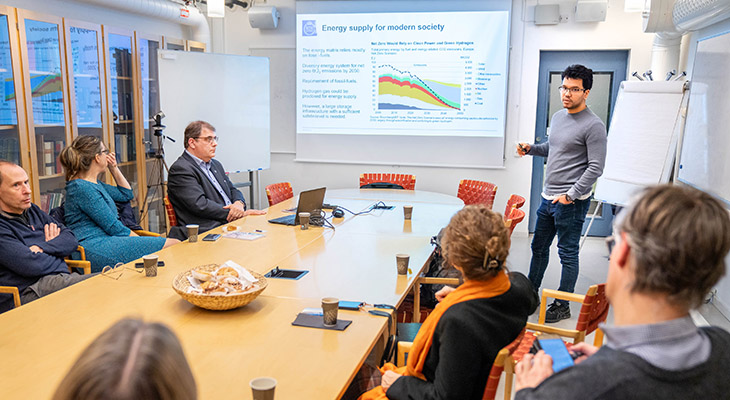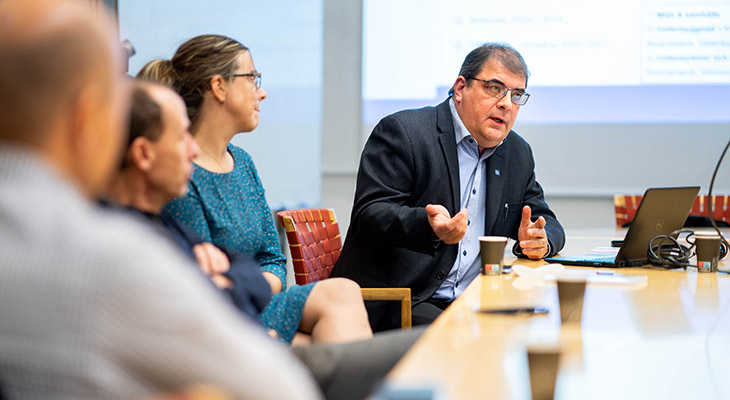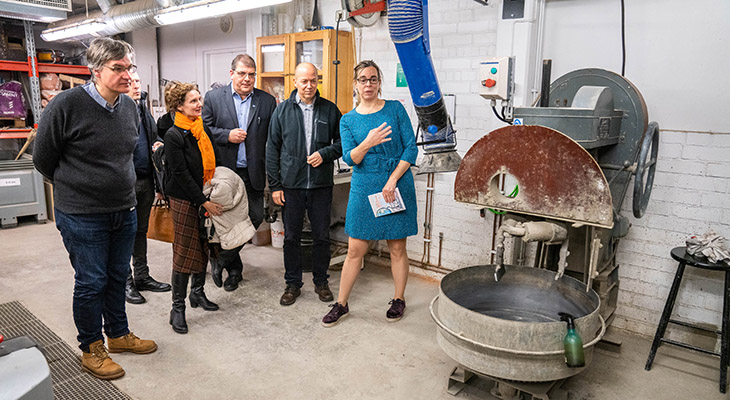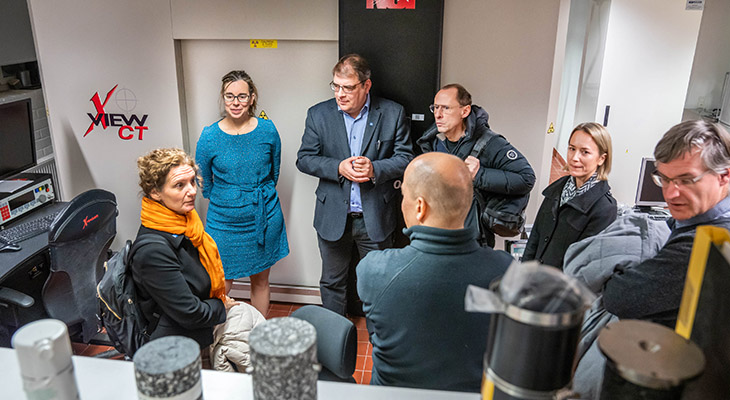Meet the researchers behind new storage solutions for hydrogen and spent nuclear fuel

The Energy Platform’s last study visit of the year was to the Department of Civil and Architectural Engineering at the School of Architecture and the Built Environment (ABE). During the visit, participants met researchers working on a range of areas ranging from storage of spent nuclear fuel, hydrogen storage, and the construction of hydroelectric dams.
Every year, KTH Energy Platform makes a series of school visits with the goal of contributing to new collaborations and initiating more research projects between KTH's energy researchers. At the Department of Building Science, the platform was welcomed by Annika Gram, head of department, with an introduction to the department's activities. The department is made up of the following divisions: Concrete Structures, Structural Engineering and Bridges, Building Materials, Sustainable Buildings, Constructional Engineering and Design, Soil and Rock Mechanics, and Transport Planning.
Around 180 researchers work at the department, and half of its students take subjects in Constructional Engineering and Design.
Storage of spent nuclear fuel
Next, Diego Mas Ivars, Adjunct Professor of Rock Mechanics, presented his work on preparing for the long-term storage of spent nuclear fuel. He divides his time between KTH and the Swedish Nuclear Fuel and Waste Management Company, (SKB), where he has worked since 2015.
In January 2020, the Swedish government granted SKB permission to build a repository for spent nuclear fuel in Forsmark, in Östhammar municipality, east central Sweden. However, research and technological development related to the facility has been conducted for more than 40 years in collaboration with universities, research institutes and other education institutions in Sweden and abroad.

Mas Ivars spoke about the development of the KBS-3 method , which is based on three protective barriers: copper capsules, bentonite buffer, and bedrock. Knowledge of rock mechanics contributes to identifying, understanding and conceptualising rock characteristics.
The goal is to create an environment that enables the storage of spent nuclear fuel for one million years. Previously, spent fuel was never intended to be brought up from the facility once stored, but now storage is being created to allow further processing of spent fuel using new technologies.
Everything from heat generated by decaying fuel to the impact of earthquakes, glaciers, permafrost, pressure changes and many other factors have been considered in the design of the facility. This work is conducted in collaboration between a number of different experts in areas such as rock mechanics, geology, hydrology and thermal reactions. Rock mechanics includes rock impacts at scales ranging from micrometres to kilometres.
There is already a facility for the final storage of short-lived radioactive waste, (SFR), at Forsmark. This is now planned to be expanded in the near future. Demolition waste from decommissioned Swedish nuclear power plants will be stored here.
Underground hydrogen storage
Davi Rodrigues Damasceno then spoke about his doctoral work involving underground hydrogen storage, a project conducted in collaboration with Hybrit and others, in which hydrogen plays a key role in producing fossil-free steel.

When an underground cave or cavity is used to store hydrogen, the hydrogen needs to be stored under pressure. And depending on the amount of hydrogen, pressure changes in containers need to be managed. Damasceno focuses on the interaction between rock, concrete and steel layers, or cladding, used to store hydrogen. Steel is needed to keep containers tight, while the rock and concrete retain pressure. The technology is known as Line Rock Cavern and has been partially developed at KTH.
Similar storage solutions are already in place, for example in Skallen mountain in Kvibille outside Halmstad, which offers storage capacity of up to 40,000 cubic metres of natural gas. In Svartöberget in Luleå, next to Hybrit’s test facility, a pilot facility is now being built that will hold 100 cubic metres of hydrogen.
As part of his doctoral thesis, Damascenos has developed a series of models to evaluate and manage risks associated with the construction of hydrogen storage using the Line Rock Cavern method.
Construction focused on hydroelectric power
Anders Ansell, Professor of Concrete Construction and Head of the Concrete Structures Division, rounded off the presentations. The division conducts research in approximately nine areas, including advanced construction methods, material properties and shotcrete.

It also conducts research into concrete structures for the hydropower sector, and specialises in dam construction, entire power plant systems and hydraulics.
There are currently around 1,000 hydroelectric dams in Sweden; many of them were built in the 1950s and 60s and are in need of various forms of overhaul or repair. The Concrete Structures Division has a number of ongoing research projects focused on hydropower. These include projects that will map how concrete foundations are affected when hydropower is used as an intermittent energy source to balance the energy system as a whole. Resilience theory is a key area of knowledge in this respect.
The department collaborates with other KTH departments, for example Mechanics. It is also a partner of the Swedish Hydropower Centre, (SVC), which conducts research and development into hydropower and dams to contribute to a renewable energy system. Their research also benefits from other laboratories, such as Vattenfall in Älvkarleby, to study how different sections of concrete dams react under different water flows.

The visit wrapped up with a tour of the department, which included student workshops and laboratories. There was a demonstration of one of the department’s most important instruments: a high-resolution CT, the North Star Imaging X5000. The machine creates X-ray images of everything from asphalt and concrete to soil and stone at different temperatures. This helps researchers conduct analyses of various constructions, damage signatures, and run advanced image-based modelling.

The visit was led by Christophe Duwig, Deputy Director of the Energy Platform, and Lina Bertling Tjernberg, Energy Platform Director. Kerstin Forsberg, from the School of Engineering Sciences in Chemistry, Biotechnology and Health, and Pierre Bodin, Research Support Office, also participated.
The Energy Platform also visited ABE on site at the end of 2021 , and digitally in 2021 and 2019 .
Text: Magnus Trogen Pahlén